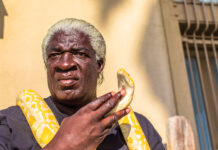Stairs lead up from the garage to the main living area of the split level apartment. The color palette in the room is fairly neutral, from the white walls to the beige couch. However, in one corner near the front entrance, colorful shoes sit on display. Red, purple and green sneakers pop among the grey and white. This is Francisco Flores’ home, and the shoes are part of his sneaker collection.
Flores is a sneakerhead, which is defined as a person who collects shoes as a hobby or for financial gain.
Forbes magazine’s contributing writer Matt Powell reported that sports shoe sales in 2013 totaled $22 billion, with the sneakerhead portion making up about 5 percent.
For most sneakerheads, it’s not about the money they can make reselling their shoes. For them, it’s about the passion and the fun they have collecting them.
Flores, a travel agent, is a burgeoning collector who started buying shoes recently, though the interest has been there for years.
“I wanted to become a sneakerhead since I was a little kid, but we couldn’t afford shoes growing up,” Flores says. “Within the last year and a half, I just boomed into a huge sneakerhead, and now it’s like I’ve got to have every single shoe that comes out.”
As a kid watching Michael Jordan, Flores wanted to emulate the sports icon.
“I wanted to fly like Mike,” he says.
Flores isn’t alone. According to Mental Floss magazine, in 1985, Jordan sparked the popularity of a new shoe called Air Jordan I, when he rebelled against then-NBA Commissioner David Stern’s rule of wearing non-regulation shoes on the court. This act inspired many people to copy their hero.
Ron Castro is the buyer for Primitive, an urban wear and shoe store where sneakerheads frequent for the latest “kicks.” Castro believes the infamous red and black sneakers—along with Nike’s strong marketing campaign—was the beginning of basketball shoes fusing with the sneakerhead culture. Though Converse brand shoes had always been related to basketball, Nike, with Stern’s unwitting help, invigorated the culture surrounding sneakers.
“Jordans permeate cultures,” Castro says. “It turns into a fashion thing where certain people wear Jordans, and you equate that to fashion and to sneakers and not back to him playing basketball necessarily.”
Jordans are just one instance of how sneakerhead culture is an amalgamation of several other types of cultures. Castro says rappers such as Kanye West mix street wear with high fashion clothing.
“It’s this whole image that people are trying to build wearing these sneakers. So that hits that market, and also people who like sneakers in general. It hits different levels. You can’t really pigeonhole that consumer into one specific person,” Castro says.
John Dinh, who considers himself more of a collector rather than a sneakerhead, is representative of the type of person who didn’t get into sneakers because of basketball but still loves the shoes.
For Dinh, it’s always been about the design and functionality of sneakers.
“As a kid I always wanted to be the fastest runner, the highest jumper, so on and so forth. So athletes had a big impact on me buying sneakers originally,” he says. “And then there was one pair that just caught my eye, and since then I have been hooked.”
The shoes that started his love affair were the Air Max ‘90s Infrared, originally released in 1990. Dinh recalls seeing them for the first time and loving the aesthetic.
“It had a very neutral color scheme with this bright splash of vibrant red accents,” he says.
Over the last 15 years, Dinh has amassed a collection of more than 300 pairs of shoes. Similar to Flores, he’s not only drawn to the aesthetic of the shoes but to the performance as well.
Something he loved about the Air Max ‘90s shoes was a new technological advancement, introduction of an air bubble in the bottom of the shoe, which he says increased comfort and stability.
Castro says one of the major misconceptions about sneakerheads is that they’re needlessly spending money.
“There’s an image of being thuggish and that people are wasting their time, but that’s not true. There’s a huge return on investment,” he says.
Dinh, who works in the financial industry, believes that sneaker collecting isn’t valued in society because people who are not involved in the culture do not understand it. Dinh compares high-end shoes to precious metals because both can rise in value over time.
Flores believes that if he sold his collection he could probably use the profit for a down payment on a house.
Flores has an 8-year-old son who is turning into a mini-sneakerhead. He says it is hard to justify paying the full retail price for elementary age kids knowing that they will be running around and beating them up. Flores handles his son’s desire to copy his father with patience—and taking it one pair at a time.
For Castro, it is common to see multi-generational love for these shoes and he often sees parents bring their kids into the store.
He urges people when it comes to collecting to be themselves, regardless of what others may think.
“I encourage them to be different, he says. ‘Like what you like; don’t do it because you think it’s cool. Do it because you genuinely like it.”



